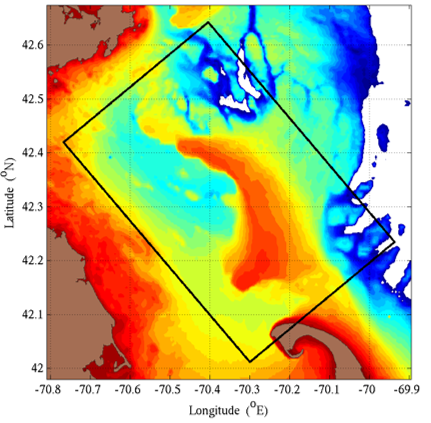Bayesian Intelligent Ocean Modeling and Acidification Prediction Systems (BIOMAPS)
|
P.F.J. Lermusiaux, P.J. Haley, Jr., A. Gupta, C. Mirabito, C.K. Kulkarni, M. Doshi Massachusetts Institute of Technology
|
Project Summary Ongoing MIT-MSEAS Research Additional Links MSEAS BIOMAPS-supported Publications Background Information
|

|
|
| This research is sponsored by MIT Sea Grant. | |||
Project Summary
The overarching goal of this project is to develop and demonstrate principled Bayesian intelligent ocean modeling and acidification prediction systems that discriminate among and infer new ocean acidification (OA) models, rigorously learning from data-model misfits and accounting for uncertainties, so as better monitor, predict, and characterize OA over time-scales of days to months in the Massachusetts Bay and Stellwagen Bank region.
Background information is available below.
| Top of page |
Ongoing MIT-MSEAS Research
Specific Objectives:
- Extend and apply our capabilities in multi-resolution physical-biogeochemical modeling (implicit 2-way nesting, tiling, etc.), uncertainty and predictability predictions, downscaling from global models, Lagrangian transport, Lagrangian–Eulerian data fusion and assimilation, path planning, and information theory for adaptive sampling, to better understand, monitor and predict OA processes
- Utilize our new stochastic physics-based Bayesian and deep machine learning methods to improve understanding of OA, rigorously discriminate among a hierarchy of OA models, and discover efficient OA model parameterizations and formulations
- Apply and test the above advances in the Boston Harbor, Massachusetts Bay (MB) and Stellwagen Bank (SB) region, integrating a wide range of data sets (atmospheric, in situ, satellite, and coastal remotely sensed) and including the demonstration of optimal monitoring guidance, forecasting of the most informative data to-be-collected, and risk assessment under uncertainty
- Utilize our data-assimilative results to identify and characterize the multiscale acidic water transports and transformations from the ocean surface to the interior, the effects of river discharges, and the subsequent mixing and chemical evolution of water masses in the region
- Collaborate with Sea Grant, colleagues, government agencies (e.g., MWRA, NOAA), local cities and towns (e.g., Gloucester), and fishermen partnerships, to exchange and transfer data and expertise
Publications
MSEAS BIOMAPS-supported Publications
Awards
| Top of page |
Additional BIOMAPS Links
- Presentations from PIs meeting (June 25, 2019)
- Nov 19, 2019 MIT Sea Grant Funded PIs Meeting Presentation Video (MSEAS talk starts at about 1 hour 18 minutes)
| Top of page |
Background Information
We will leverage our integrated physical-biogeochemical-acoustical modeling system (Multidisciplinary Simulation, Estimation, and Assimilation Systems, MSEAS). This software (Haley and Lermusiaux, 2010; Haley et al., 2015) has been developed over many years but has new unique capabilities aligned with the needs of the MIT Sea Grant theme on OA. These include information-based monitoring, multi-dynamics and multi-resolution modeling, massive real-time ensemble forecasts (105 members) for uncertainty quantification, data fusion and assimilation, Bayesian and deep machine learning of models, and quantitative risk management (Lermusiaux et al, 2007, 2010, 2017a,b; Subramani, 2018). Using historical and synoptic ocean data of opportunity, as well as targeted observations to-be-collected, we will discriminate among competing OA model structures and formulations, i.e. relations that govern the OA state, and learn accurate parameterizations and reaction terms. A difference with respect to prior efforts is that our Bayesian machine learning accounts for uncertainties, providing skill scores for competing models and quantitative risk management. We will utilize idealized and realistic simulations to incubate methods and contrast OA models, but results will be validated using extensive real ocean data.
At the core of MSEAS are three solvers of governing fluid and ocean dynamics equations. The first solver is part of an extensive modeling system for hydrostatic primitive-equation dynamics with a nonlinear free surface and adaptive biogeochemical-ecosystem models. It is used to analyze and quantify tidal-to-large-scale physical and biogeochemical processes over regional domains with complex geometries and varied interactions. The MSEAS capabilities that will be leveraged include: fast-marching coastal objective analysis (Agarwal and Lermusiaux, 2011); estimation of spatial and temporal scales from data (Agarwal, 2009); initializations of fields and ensembles (Lermusiaux et al., 2000; Lermusiaux, 2002; Haley et al., 2015); nested data-assimilative tidal prediction and inversion (Logutov and Lermusiaux, 2008); implicit two-way nesting and tiling (Haley and Lermusiaux, 2010); stochastic subgrid-scale forcing (Lermusiaux, 2006); adaptive data assimilation, sampling and learning (e.g. Lermusiaux, 2007; Schofield et al., 2010); adaptive biogeochemical modeling (Besiktepe et al., 2003; Lermusiaux et al., 2010); Lagrangian coherent structures and their uncertainties (Lermusiaux et al., 2006); and many-task computing and the control of egacy codes (Evangelinos et al., 2006, 2011).
| Top of page |


